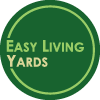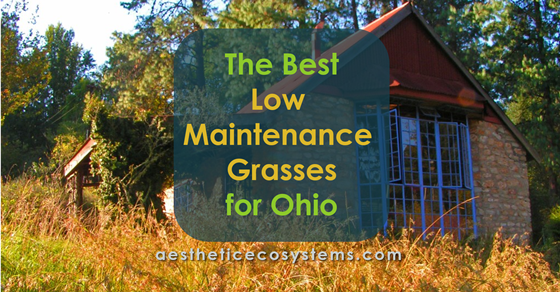If you live in or close to Ohio, this article is a must read for your landscape ideas on ornamental grasses and groundcovers.
Get the expert opinion of low maintenance landscape designers from across Ohio on the top low maintenance ornamental grasses and groundcovers they use in their designs for front yard landscaping.
Below is a list of easy ornamental grasses and groundcovers for Ohio, followed by the contact information of these designers.
If you’re looking for front yard design ideas to create a beautiful healthy landscape without tons of yard work, reach out to them for some awesome design help!
When you’re looking to save time on yard work, the right plants in the right place can really make a difference. When considering grasses or groundcover for your landscape, it is important to consider the growing conditions of your specific garden location, as well as the aesthetics and form of your intended planting.
Important considerations for easy perennial plants and low maintenance landscapes:
- Know your soil type
- Get a soil test!
- Know your pH
- Know your soil texture (sand, loam, silt, clay)
- Select plants adapted to:
- Your soil type
- The water availability in your garden
- The fertility level of your site
- Other nearby plants
- Consider aesthetics
- Right plant form
- Proper plant groupings
- Consider plant growth
- Seed dispersal
- Growing habit
- Spreading habit
Once you’ve considered the right conditions for your ornamental grasses, here are some awesome suggestions on what to plant!
Each of the plants listed below were recommended by two or more designers to be included.
Most of these grasses are easy perennial plants native to this region and bring a lot of beauty and texture to your landscape. Some are short-lived perennials or self-reseeding annuals that can reseed to come back each year. Some are non-native exotics that are well adapted to the growing conditions of Ohio without spreading profusely in the wild.
Also be sure to check out the other sister articles to this one:
Get a free copy of all plants in one easy to navigate file!
Grasses
Grasses provide wispy texture throughout the year, especially in cold seasons. There is a wide variety of native grasses that can provide beautiful texture to your garden. Some make great ornamental grass accents, others make a great low maintenance groundcover.
- Bluestems
- A native to the Great Plains and prairies throughout the United States, this tall grass brings texture and even color to a nice design. Makes a great native ornamental grass.
- Key species and cultivars:
- Big Bluestem (Andropogon gerardii )
- Sun: Full
- Soil: Wide Range
- Fertility:
- Moisture: Dry to Average
- Height: 5 to 8
- Bloom Time: Late Summer
- Bloom Color: Insignificant
- USDA Zone: 4 to 9
- Origin: US
- Resources:
- Designer Solomon Gamboa says: “Big Bluestem was the dominant grass of many prairie types. It has an ability to sway in the wind more gracefully than most grasses, the challenge is getting it to not flop/not be too spoiled. Planting it with other larger plants tightly, or in poorer soils/ hot sloped soils is advisable.”
- Bushy Bluestem (Andropogon glomeratus )
- Sun: Full
- Soil: Wide Range
- Fertility:
- Moisture: Average to Moist
- Height: 3 to 6
- Bloom Time: Late Summer
- Bloom Color: Insig
- USDA Zone: 5 to 9
- Origin: US
- Resources:
- Designer Solomon Gamboa says: “The more sun the better, the moister the soil, the more likely they are to lean heavily as they put on seed. Great companion plant with shorter plants particularly those that bloom before midsummer-before it gets taller. Can handle any dry microclimate, as long as there is some soil present. Don’t cut back until March for winter interest”
- Elliot’s Bluestem (Andropogon gyrans )
- Sun: Full
- Soil: Wide Range
- Fertility:
- Moisture: Dry to Average
- Height: 2 to 3
- Bloom Time: Late Summer
- Bloom Color: Insignificant
- USDA Zone: 4 to 9
- Origin: US E
- Resources:
- Designer Solomon Gamboa says: “The more sun the better, the moister the soil, the more likely they are to lean heavily as they put on seed. Great companion plant with shorter plants particularly those that bloom before midsummer-before it gets taller. Can handle any dry microclimate, as long as there is some soil present. Don’t cut back until March for winter interest”
- Broom Sedge (Andropogon virginicus )
- Sun: Full
- Soil: Wide Range
- Fertility:
- Moisture: Dry to Average
- Height: 2 to 3
- Bloom Time: Late Summer
- Bloom Color: Insignificant
- USDA Zone: 4 to 9
- Origin: US
- Resources:
- Grama Grasses
- A US native grass across a broad range. Grows to a short height for smaller garden grass height. Unique seed heads set this grass apart from others with its oat-like heads that hang off of one side of the seed stalk.
- Key species and cultivars:
- Side oats grama (Bouteloua curtipendula )
- Sun: Full
- Soil: Wide Range
- Fertility:
- Moisture: Dry to Average
- Height: 1 to 2
- Bloom Time: Late Summer
- Bloom Color: Insignificant
- USDA Zone: 4 to 9
- Origin: US
- Resources:
- Designer Solomon Gamboa says: “Planted tightly in mass, Side Oats can create an interesting grass-aesthetic. Would also be good companion plants for Dwarf Goldenrod and Purple/White Praiire Clover – sized natives.”
- Blue Grama (Bouteloua gracilis )
- Sun: Full
- Soil: Sandy to Loam
- Fertility: Wide Range
- Moisture: Dry to Average
- Height: 5 to 1
- Bloom Time: Late Summer
- Bloom Color: Insignificant
- USDA Zone: 3 to 10
- Origin: US MW
- Resources:
- Sedge
- Sedges are a widely diverse group of plants from across the world. These selected varieties are native to this region of the US, thrive in Ohio climate and conditions, and provide unique aesthetic value to a garden or as a groundcover.
- Key species and cultivars:
- Fringed Sedge (Carex crinita )
- Sun: Part to Full
- Soil: Loam
- Fertility: Average
- Moisture: Moist to Saturated
- Height: 1 to 3
- USDA Zone: 3 to 8
- Origin: US E
- Resources:
- Palm Sedge (Carex muskingumensis )
- Sun: Part to Full
- Soil: Loam
- Fertility: Average
- Moisture: Average to Saturated
- Height: 1 to 3
- USDA Zone: 4 to 9
- Origin: US E
- Resources:
- Sedge (Carex pensylvanica )
- Sun: Shade to Part
- Soil: Loam
- Fertility: Average
- Moisture: Dry to Average
- Height: 5 to 1
- USDA Zone: 3 to 8
- Origin: US E
- Resources:
- Fox Sedge (Carex vulpinoidea )
- Sun: Part to Full
- Soil: Loam
- Fertility: Average
- Moisture: Moist to Saturated
- Height: 1 to 3
- USDA Zone: 3 to 7
- Origin: US
- Resources:
- Switch Grass
- Switch grass has beautiful foliage with a wispy appearance. This makes a great ornamental grass accent or backdrop.
- Key species and cultivars:
- Northwind Switch Grass (Panicum virgatum Northwind)
- Sun: Part to Full
- Soil: Wide Range
- Fertility: Poor to Average
- Moisture: Dry to Moist
- Height: 3 to 6
- Bloom Time:
- Bloom Color:
- USDA Zone: 5 to 9
- Origin: US
- Resources:
- Designer Amy Dutt says: “to 5-6 ft tall with silvery blue foliage. Stays upright (doesn’t flop). Seeds for birds. Very handsome. Shorter, reddish variety Panicum virgatum ‘Shenandoah’ adds color and ‘fluffy’ texture.”
- Little Bluestem
- Another Great Plains prairie grass. As expected, much shorter than Big Bluestem, provides a medium-height grass to the garden with plenty of texture. Widely adaptable.
- Key species and cultivars:
- Little Bluestem (Schizachyrium scoparium )
- Sun: Full
- Soil: Wide Range
- Fertility: Wide Range
- Moisture: Dry to Average
- Height: 2 to 4
- USDA Zone: 3 to 9
- Origin: US
- Resources:
- Designer Solomon Gamboa says: “The more sun the better, the moister the soil, the more likely they are to lean heavily as they put on seed. Great companion plant with shorter plants particularly those that bloom before midsummer-before it gets taller. Can handle any dry microclimate, as long as there is some soil present. Don’t cut back until March for winter interest”
- Indian Grass
- A very beautiful, tall grass native to the US. Its seedheads open later in season, providing later texture and visual interest in the garden.
- Key species and cultivars:
- Indian Grass (Sorghastrum nutans )
- Sun: Full
- Soil: Wide Range
- Fertility: Poor to Average
- Moisture: Dry to Average
- Height: 3 to 5
- Bloom Time:
- Bloom Color:
- USDA Zone: 4 to 9
- Origin: US
- Resources:
- Designer Solomon Gamboa says: “Perhaps the most ornamental of our taller warm season grasses. The flowers and seed heads are exceptional. The foliage can be an average green or blue based on seed source. If the seed is adapted to local conditions, it should be the last grass to bloom, adding to a late summer display of wildflowers significantly.”
- Prairie Dropseed
- This low growing grass again provides visual interest, especially when its seedheads shoot and display their seeds. Works as a groundcover.
- Key species and cultivars:
- Prairie Dropseed (Sporabolus heteropelis )
- Sun: Full
- Soil: Wide Range
- Fertility: Poor to Average
- Moisture: Dry to Average
- Height: 5 to 3
- Bloom Time: Late Summer
- Bloom Color: Insig
- USDA Zone: 3 to 9
- Origin: US MW E
- Resources:
- Designer Solomon Gamboa says: “One of the most beautiful native warm season grasses, very fine textured, will extend fragrant grass blooms higher than most low growing plants. Best planted in mass as opposed to isolated.”
Groundcover
- Sedum
- Sedums are widely dispersed across the world, with different species from various climates and regions. The below species include one native and one exotic. Both have great low-growing texture and foliage that withstand tough conditions yet provide visual interest.
- Key species and cultivars:
- Sedum (Sedum reflexum Angelina)
- Sun: Part to Full
- Soil: Sandy to Loam
- Fertility: Average
- Moisture: Dry to Moist
- Height: 5
- Bloom Time: Jun to Aug
- Bloom Color: Yellow
- USDA Zone: 4 to 9
- Origin: Europe
- Resources:
- Woodland stonecrop (Sedum ternatum )
- Sun: Part to Full
- Soil: Loam
- Fertility: Average
- Moisture: Average
- Height: 25 to 0.5
- Bloom Time: Apr to May
- Bloom Color: White
- USDA Zone: 4 to 8
- Origin: US E
- Resources:
Designers
I want to thank the following designers for their expert input in providing this wonderful resource for easy perennial plants.
If you need help with landscape ideas from backyard landscaping to front yard landscaping ideas, consider contacting one of these designer in your area for a beautiful healthy landscape that is low maintenance and fun!
Akron
- Sabrena Schweyer – Salsbury-Schweyer, Inc
Cincinnati
- Diana Boyd – Keystone Flora Native Plant Nursery
- Wes Duren – Marvin’s Organic Gardens
- Solomon (Solly) Gamboa – Indigenous Landscapes
- John Hemmerle – Our Land Organics
- Jacob Thompson – Barefoot Design
- Howie Zuefle – Verdure Landscaping
- zueflehd@gmail.com
- 513-259-3504
Columbus
- Amy Dutt – Urban Wild Ltd
- urbanwilddesignandplanning@gmail.com
- 614-547-WILD
- Debra Knapke – The Garden Sage
Get a free copy of all plants in one easy to navigate file!
Photo Credits: Jack Holloway













Leave A Comment